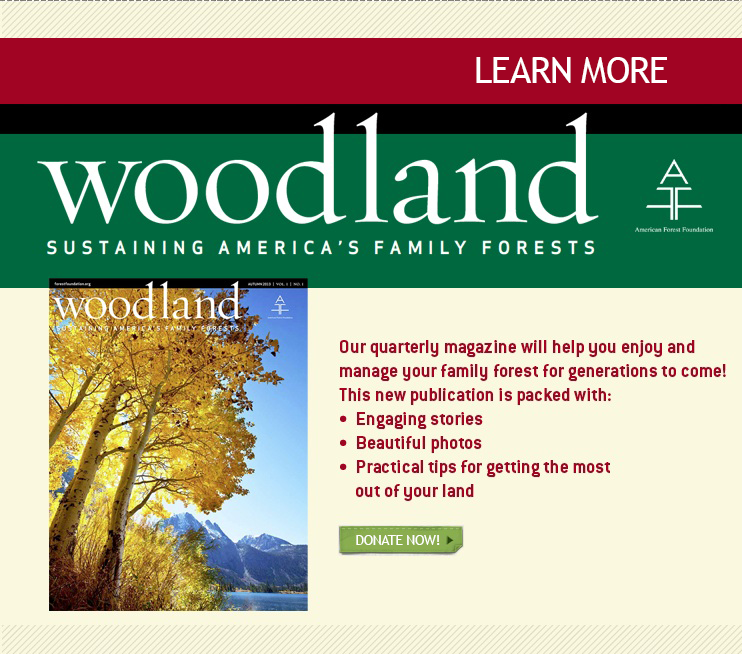The Many Homes of the Family Forest Community
By Bettina Ring, Senior Vice President for Family Forests
The Spanish word “querencia” describes a place where one feels safe, a place from which one’s strength of character is drawn. For many of us, this may be a community or an outdoor space near where we grew up or where we live today. Interestingly, in Greek, “ecology” means “the study of our house,” and an “ecosystem” means a “system of our houses.”
I’ve been reflecting recently on the ecosystem of the family forest community—our many houses—and on my recent travels around our neighborhood and what makes our many houses feel like many homes to me.
For example, in September I visited one of my family forest homes at the Land Trust Alliance Rally in New Orleans. The Land Trust Alliance is a national land conservation organization—comprising 1.5 million dedicated professionals, volunteers and supporters—that works to conserve and steward natural resources across America. At the rally, I mingled with 1,500 “family members” who all care about place—from a local, regional, state and national perspective. There I heard author Barry Lopez speak of place and the importance of community elders. I had the honor of witnessing a former neighbor, colleague and elder in his own right, Larry Kueter, chair of the Land Trust Alliance Accreditation Commission, receive the Kingsbury Browne Conservation Leadership Award and Fellowship. Larry was recognized for his long-term dedication to landowners and local, state and national conservation organizations. His leadership in guiding and advancing the protection and standards of land conservation parallels the leadership I see in our partners who are advancing the American Tree Farm System® (ATFS) certification standards across the country.
Then I visited another family forest home at the National Association of State Foresters (NASF) annual meeting in Bath County, Virginia. This felt like home for two reasons. First, because of the central role our state foresters play in the family forests and Tree Farm community at large; and, second, because of my own roots in Virginia. Going deep
into the Shenandoah Valley of Virginia and back to NASF was very grounding and—like other visits home—also made me feel a bit old.
 Old-feeling or not, it was wonderful to see folks I walked, talked and worked with years ago at one of my other family forest homes—the Virginia Department of Forestry, where I worked for 14 years in various capacities, including as deputy state forester. Among the Virginia “family” members I reconnected with at the NASF meeting were Area Forester John Wright of Bath County, Area Forester Joe Lehnen of Shenandoah County, Director of Resource Protection John Miller and State Forester Carl Garrison.
Old-feeling or not, it was wonderful to see folks I walked, talked and worked with years ago at one of my other family forest homes—the Virginia Department of Forestry, where I worked for 14 years in various capacities, including as deputy state forester. Among the Virginia “family” members I reconnected with at the NASF meeting were Area Forester John Wright of Bath County, Area Forester Joe Lehnen of Shenandoah County, Director of Resource Protection John Miller and State Forester Carl Garrison.
Like the community elders I heard about in New Orleans, seeing Carl shuck oysters from the Chesapeake Bay at the recent NASF meeting reminded me of the 1990 NASF annual meeting. There, then-State Forester of Virginia Jim Garner showed the ropes of shucking Virginia oysters to then-State Forester of Louisiana Paul Frey, sharing the rituals and bounties of one family forest home with another.
Other family forest homes I visited in the past few months include Vermont, where I was able to spend time with the leaders of our state Tree Farm community as they recognized John Hemenway as Vermont Tree Farmer of the Year; Wisconsin, where I spent time with the leaders of our Tree Farm network and the staff of the Aldo Leopold Foundation at Land Ethic for Land Stewardship workshops; and Washington state, where I witnessed the incredible collaboration that has been taking place among the local Tree Farm Committee
and public, private and nonprofit partners, as they hosted our ATFS Certification Committee meeting.
I am extremely grateful to be part of these family forest homes—and many more—where we connect with, recognize and embrace the people who love the land. As a forester, this is all I can ask for—an ecosystem of people and landscapes who are all interconnected and interdependent and are so very fortunate to embrace “querencia” with our heart and soul.










Comments: